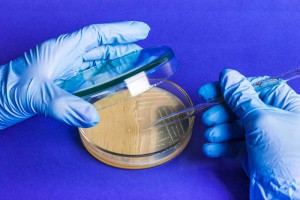It is estimated that all the bacterial species so far described represent only a tiny fraction of the total. The rest remain unknown to science because they are “unculturable” in standard (or known) laboratory media. Given that many antibiotics were first isolated from environmental bacteria, it seems likely that these as yet unknown organisms could also be a rich source of potential new drug candidates. The desperate need for new strategies to combat multi-drug resistant infections gives impetus to studies investigating how we can culture some of these “unculturable” bacteria and uncover their potential as a source of much-needed new treatments.
Go Straight for the Genome
One way to study unculturable organisms bypasses the need to culture them at all, instead directly interrogating their genetic information by whole-genome sequencing. One paper decribes work to identify new antimicrobial drug candidates by screening the genetic data gathered from the human microbiome project. In that paper, the authors looked for genes similar to those of existing small molecule drug candidates. The drawback to this approach is that you can only search for new drugs that are similar to known compounds, because you have to know what you are looking for in order to find it.
Make a Home Micro-Environment
A paper published January 15 in Nature showcases a second approach—in situ culture–a method that directly addresses the “unculturable” problem. In that study, the authors grew soil bacteria in their natural environment in diffusion chambers on an “iChip” device. To do this, a soil sample was diluted to a point where one bacterial cell was delivered to each channel on the chip, which was then covered with a semi-permeable membrane and placed back in the soil to grow.
Extracts from 10,000 isolates grown on chips in this way were screened for antimicrobial activity against Staph aureus in a plate overlay assay. One extract from a new species of proteobacteria showed good activity, and was further characterized. The new antibiotic, named teixobactin, showed good activity against Gram-positive bacteria, including common multi-drug resistant organisms like MRSA and C. difficile. Further analysis showed that teixobactin targets a similar stage in cell wall development as the antibiotic Vancomycin, but that teixobactin was also active against Vancomycin-resistant organisms.
One of the most promising aspects of this study was that teixobactin-resistant mutants did not develop, even after passage on low doses of the antibiotic. The authors point out that Vancomycin resistance took many years to develop, and speculate that because teixobactin targets the same type of pathway in cell wall synthesis it may also take a long time for resistance to emerge.
We don’t hear about new antibiotics very often, and it’s even rarer to hear about antibiotics with lower risk of causing resistance. This study is exciting because teixobactin isn’t the only good news here. The approach to culturing previously unculturable soil organisms provides a way to keep on searching for new antimicrobials and provides a lot more places to look.
Here’s the Paper
Ling, L., Schneider, T., Peoples, A., Spoering, A., Engels, I., Conlon, B., Mueller, A., Schäberle, T., Hughes, D., Epstein, S., Jones, M., Lazarides, L., Steadman, V., Cohen, D., Felix, C., Fetterman, K., Millett, W., Nitti, A., Zullo, A., Chen, C., & Lewis, K. (2015). A new antibiotic kills pathogens without detectable resistance Nature, 517 (7535), 455-459 DOI: 10.1038/nature14098
Isobel Maciver
Latest posts by Isobel Maciver (see all)
- 3D Cell Culture Models: Challenges for Cell-Based Assays - August 12, 2021
- Measuring Changing Metabolism in Cancer Cells - May 4, 2021
- A Quick Method for A Tailing PCR Products - July 8, 2019

